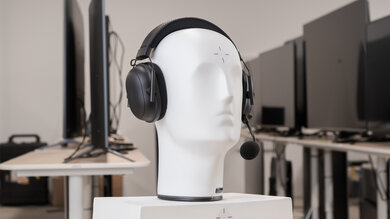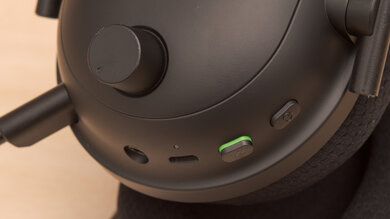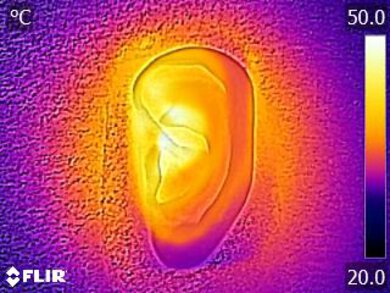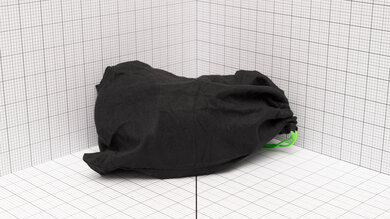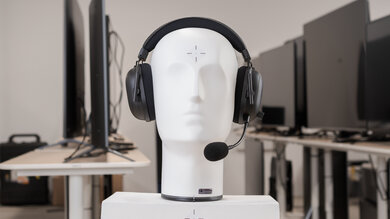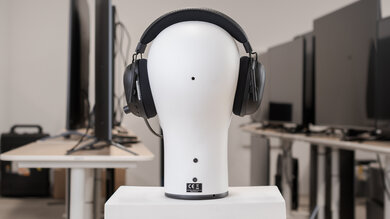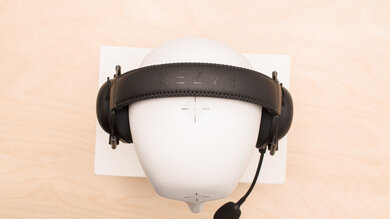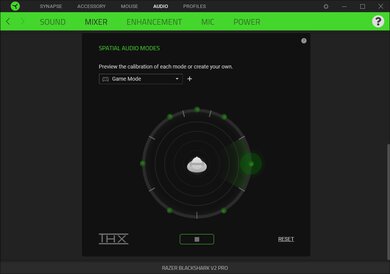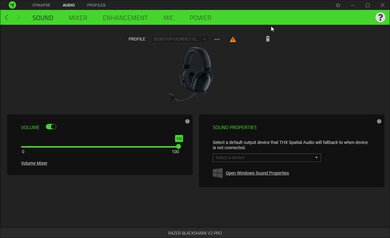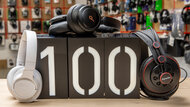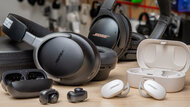The Razer BlackShark V2 Pro Wireless 2020 are similar to the Razer BlackShark V2, but they can also be used wirelessly with PCs, PS4, and PS5 consoles. These gaming-oriented headphones come with lots of customization features, including a USB dongle and access to Razer Synapse software, which lets you adjust their microphone and their sound profile. Out-of-the-box, they have a bass-heavy sound profile that adds boom and punch to action-packed scenes in your favorite games. Unfortunately, they don't have a very consistent audio delivery, and they struggle to isolate against ambient noise. However, they're very comfortable, and their long continuous battery life is ideal for long gaming sessions.
Our Verdict
The Razer BlackShark V2 Pro are decent for neutral sound. Their default sound profile is bass-heavy, so it may be a bit overwhelming or muddy for listeners who prefer a neutral sound. Fortunately, there's a 10-band graphic EQ available on the Razer Synapse software to help you adjust their sound to your liking.
- 10-band graphic EQ.
- Inconsistent bass and treble delivery.
The Razer BlackShark V2 Pro are sub-par for commute and travel. They're comfortable enough to wear for long periods, and their over 23-hour continuous battery life can get you through long days on the go. Unfortunately, their bulky design isn't very portable, and they struggle to block out background noises like bus and plane engines or voices.
- Comfortable, stable fit.
- Disappointing noise isolation performance.
- Bulky design.
The Razer BlackShark V2 Pro are mediocre for sports and fitness. These bulky over-ears aren't intended to be worn while working out. They're stable enough for gaming at home, but they may fall off your ears during intense exercises. On the upside, they're very comfortable, so they shouldn't cause a lot of fatigue during long listening sessions.
- Comfortable, stable fit.
- Bulky design.
The Razer BlackShark V2 Pro are fair for office use. These comfortable headphones have over 23 hours of continuous battery life, so they can easily last through your day. They leak a bit of noise, but it shouldn't be too noticeable in an average office. Unfortunately, they don't block out a lot of background noises, so you may hear the chatter of nearby coworkers.
- Comfortable, stable fit.
- Disappointing noise isolation performance.
The Razer BlackShark V2 Pro are decent for wireless gaming. They're compatible with PCs as well as PS4 and PS5 consoles over a non-Bluetooth connection, and they have low latency. They're comfortable enough for long gaming sessions, too. Their bass-heavy sound profile adds thump and punch to action-packed scenes, and if you prefer a different sound, there are a lot of customization options in the Razer Synapse software.
- Detachable boom microphone.
- 10-band graphic EQ.
- Comfortable, stable fit.
- Inconsistent bass and treble delivery.
- Bulky design.
- USB dongle isn't compatible with Xbox One.
The Razer BlackShark V2 Pro are good for wired gaming. You can plug these headphones into your PC or into your PS4, PS5, Xbox One, or Xbox Series X controller for full audio and microphone compatibility. They're comfortable enough for long gaming sessions, too. Using the Razer Synapse software, you can access a 10-band graphic EQ for the microphone and the audio, as well as a virtual surround feature. However, this software isn't compatible with Xbox One.
- Detachable boom microphone.
- 10-band graphic EQ.
- Comfortable, stable fit.
- USB dongle isn't compatible with Xbox One.
The Razer BlackShark V2 Pro are okay for phone calls. Their detachable boom microphone can separate your voice from background noise, even if you're calling from a noisy environment. However, the mic has a mediocre recording quality and it doesn't block out a lot of background noise, which may be distracting during your call.
- Detachable boom microphone.
- Disappointing noise isolation performance.
Changelog
- Updated Jun 16, 2025:
We updated the Battery section of this review after a user brought to our attention that these headphones will deliver audio while charging. As a result of the improved Battery score, we also updated the usages.
- Updated Jul 26, 2023: We've renamed these headphones, adding the year they were released to make the difference between this model and the Razer BlackShark V2 Pro Wireless 2023 clearer.
- Updated Jul 26, 2023: We've added a comparison between these headphones and the Razer BlackShark V2 Pro Wireless 2023 in Bluetooth.
- Updated Sep 09, 2022: We've added a comparison between these headphones and the Razer Barracuda Wireless as they're both from the same manufacturer.
Check Price
Differences Between Sizes And Variants
The Razer BlackShark V2 Pro comes in one variant: Black. You can see the label for the model we tested here.
If you come across other variants of these headphones, let us know in the discussions.
Popular Headphones Comparisons
The Razer BlackShark V2 Pro are a wireless version of the Razer BlackShark V2. Overall, they have a similar design and a similar performance to the Razer BlackShark V2. However, they're compatible with PCs, PS4, and PS5 consoles over a non-Bluetooth wireless connection, and they come with a wireless USB dongle that lets you access Razer Synapse software for lots of customization options. If you're looking for more headphones, see our recommendations for the best gaming headphones, the best wireless gaming headphones, and the best PS4 headsets.
The Razer BlackShark V2 Pro Wireless 2023 are the next generation of the Razer BlackShark V2 Pro Wireless 2020 and there have been a couple of improvements in their design. While the comfort and build quality haven't changed, the 2023 model have a longer-lasting continuous battery life, a superior overall mic performance, and support Bluetooth. However, only the previous generation supports an analog connection.
The Razer BlackShark V2 Pro Wireless 2020 are better gaming headphones than the Razer BlackShark V2. Both headphones have similar overall performance, but the Pro can be used wirelessly, which is convenient. The V2 have a more neutral sound profile out-of-the-box, but both headphones come with a graphic EQ so you can customize the sound.
The Razer BlackShark V2 Pro Wireless 2020 are better gaming headphones than the Razer BlackShark V2 X. The Pro can be used wirelessly, and they come with a wireless USB dongle that's compatible with Razer Synapse software so you can customize them. However, the V2 X have a better microphone recording quality out-of-the-box.
The HyperX Cloud 2/Cloud II and the Razer BlackShark V2 Pro Wireless 2020 are gaming headsets with different strengths. The HyperX Cloud2/Cloud II is a wired-only headset with a more comfortable fit. Their mic has a much better recording quality and does a significantly better job of isolating your voice from background noise. On the other hand, the Razer are wireless headphones you can also use wired with the included 1/8" TRRS cable. Their companion software is better, too, since it gives you access to a graphic EQ and presets.
Test Results
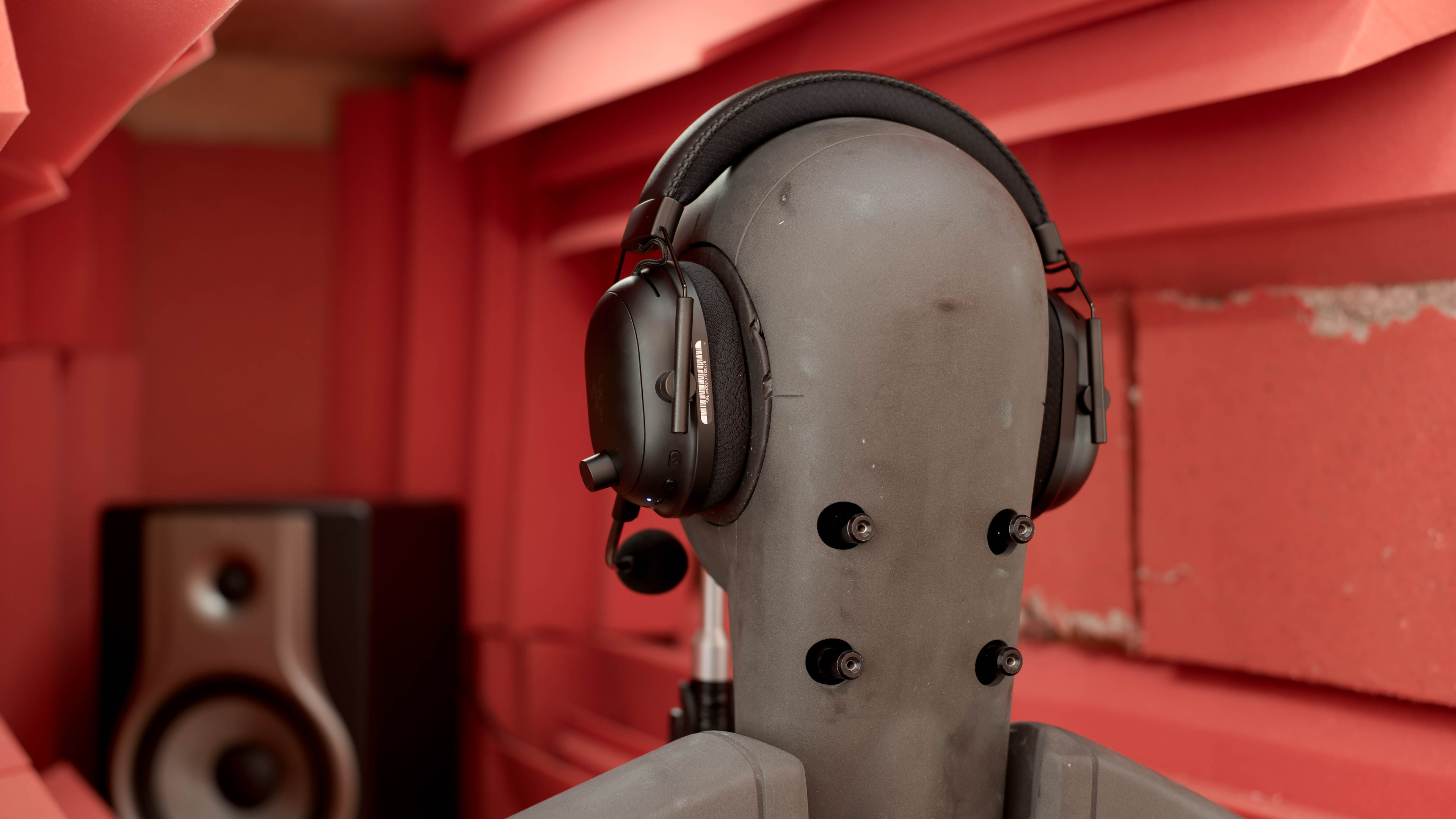
The Razer BlackShark V2 Pro have the same oval-shaped ear cup design as the Razer BlackShark V2 and the Razer BlackShark V2 X. They're made entirely of black plastic, which gives them a sleek look. You can also remove the boom microphone for a more casual look.
The Razer BlackShark V2 Pro have an easy-to-use control scheme. There's a mute/unmute button, a power on/off button, and a volume knob control. The buttons are clicky and they provide good feedback; however, the mic mute and the power button feel the same and may be mistaken for each other.
Update 03/23/2021: We've tested these headphones for breathability and updated our review.
The Razer BlackShark V2 Pro have passable breathability. They can trap in heat and while you shouldn't feel too much discomfort if you're wearing them while gaming, they can make your ears sweat a bit if you're using them during physical exercise.
The Razer BlackShark V2 Pro aren't very portable. They're bulky, and they don't swivel or fold into a more compact format. With their boom microphone attached, they're a little bit taller, too. However, you can detach the boom microphone, which makes them a little easier to store since it can't snag on anything.
The Razer BlackShark V2 Pro have a fair build quality. They're mostly made of plastic, with metal hinges and yokes, cloth-padded ear cups, and a leather and cloth-padded headband. The hinges and yokes are a potential weak point though and they don't feel as well-built as the Corsair VIRTUOSO RGB Wireless XT or Razer Kraken V3 Pro Wireless.
The Razer BlackShark V2 Pro have a bass-heavy sound profile that helps bring out the low rumbling noises in action-packed scenes of your favorite video games. Their mid-range is quite balanced, making them suitable for vocal-heavy content, too. However, their bass and treble delivery are inconsistent, so they may sound a bit different depending on their fit, seal, and positioning on your head.
These headphones have mediocre frequency response consistency. There are inconsistencies in the bass and treble ranges, so they deliver audio differently depending on their fit, seal, and positioning on your head.
These headphones have acceptable bass accuracy. The entire range is overemphasized, which adds a boomy, punchy quality to the mix. However, the response here is the average of our measurements, and your results may vary given their inconsistent bass delivery.
These headphones have very good mid accuracy. The range is pretty balanced and even, so vocals and lead instruments are clear and present in the mix. However, the overemphasis in the low-mids can make audio sound a bit muddy and cluttered.
These headphones have decent treble accuracy. Instruments sound present and detailed, but the overemphasis in the mid-treble can make sibilants like S and T sounds sharp and piercing.
The Razer BlackShark V2 Pro have adequate peaks and dips performance. There's a peak in the high-bass that adds a boomy and muddy quality to the mix. The dip in the low-mids and mid-mids pushes vocals and lead instruments towards the back of the mix, and the dip in the low-treble hurts the comprehensibility of those same instruments. The peak in the mid-treble makes sibilants piercing and painful.
These headphones have an impressive imaging performance. Their weighted group delay falls mostly below the audibility threshold, resulting in a tight bass and transparent treble. Their L/R drivers are well-matched in phase, but there's a very slight mismatch in amplitude and frequency. As a result, objects like voices and footsteps may not be that well accurately placed in the stereo image. These results are only valid for our test unit, so your experience may vary.
These headphones have a disappointing passive soundstage. Their soundstage sounds small and not very natural, which is pretty common for closed-backs. Audio seems like it's coming from inside your head, rather than in front of you.
These headphones have a decent weighted harmonic distortion performance. There are some small peaks in the treble range, but the rest of its frequencies fall within good limits, resulting in clear and pure audio reproduction.
These are the settings we used to test these headphones. Our results are only valid using these settings.
The Razer BlackShark V2 Pro have a disappointing noise isolation performance. They don't block out bass-heavy sounds like bus or plane engines, and they struggle to block out mid-range noises like voices. On the upside, they can block out higher-frequency noises like the hum of an AC unit.
These headphones have a decent leakage performance. If you're gaming at home, people around you may be able to hear some of your audio if you're playing it at high volumes.
The Razer BlackShark V2 Pro have a detachable boom microphone.
The microphone has a mediocre recording quality. Your voice sounds very deep and full, but not very natural. If you're looking for a headset with a better mic recording quality, try the Corsair HS80 RGB WIRELESS instead.
The microphone has an outstanding noise handling performance. Your voice is understandable to whoever's on the other end of the line, even if you're calling from a noisy environment.
The Razer BlackShark V2 Pro have amazing battery performance. They last over 23 hours on a single charge, which is suitable for several long gaming sessions. They even have an auto-off feature to help save battery life when they aren't in use and you can listen to audio while charging them.
The Razer Synapse software is amazing. It offers a lot of customization features, including a 10-band EQ for your music or your microphone. You can also adjust the volume level, activate a voice gate for the microphone, and adjust the power-saving feature.
These headphones aren't Bluetooth-compatible. If you're looking for Razer headphones that support Bluetooth, check out the Razer BlackShark V2 Pro Wireless 2023 or Razer Barracuda Pro Wireless.
These headphones have great connectivity over non-Bluetooth wireless. While their latency is a lot higher than the Razer Barracuda Wireless' latency, lip-syncing issues shouldn't be too noticeable, as it still falls within good limits.
Update 03/23/2021: We have retested these headphones for Xbox Series X compatibility and updated our review to reflect these changes.
You can only plug these headphones into your Xbox One or Xbox Series X controller for full audio and microphone compatibility. They can't be used wirelessly on Xbox One or Xbox Series X consoles.

